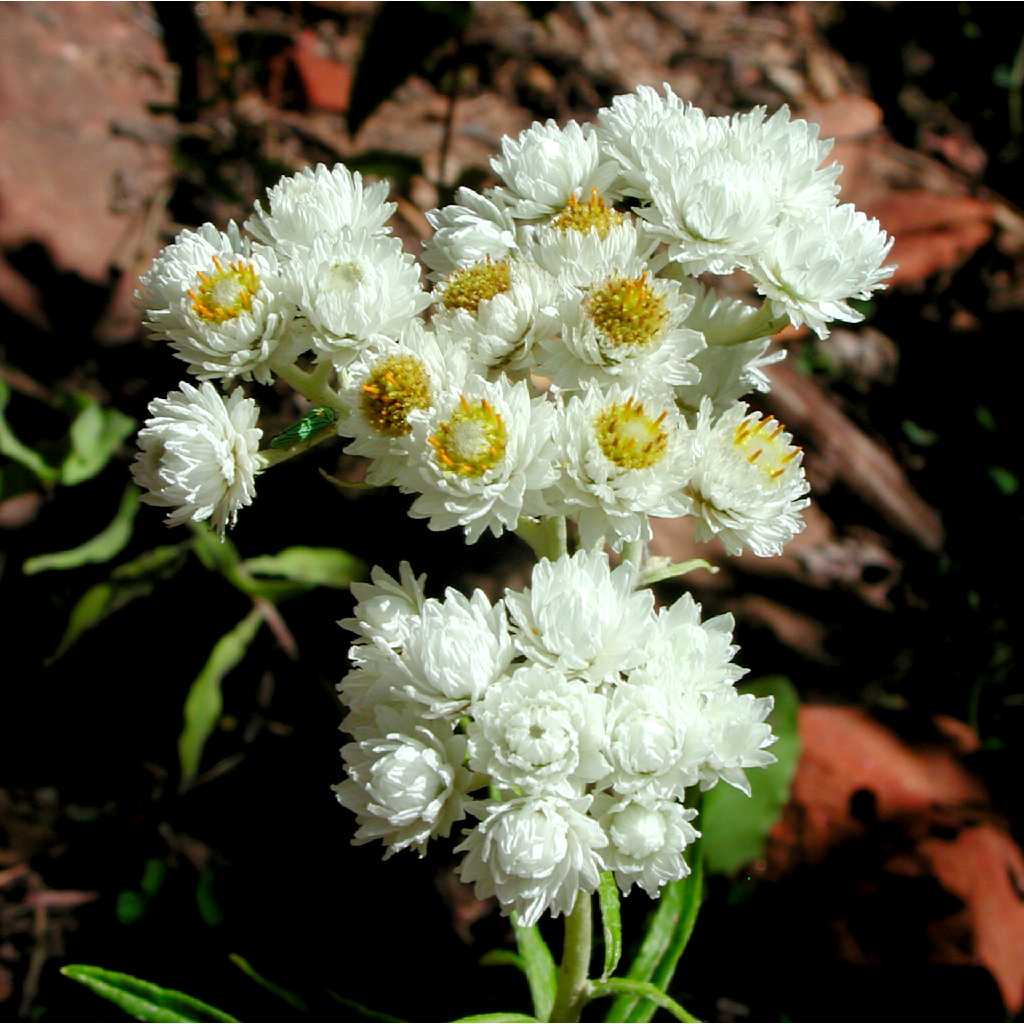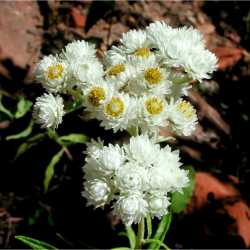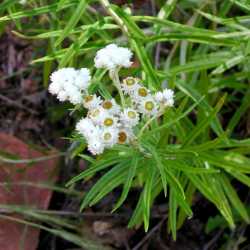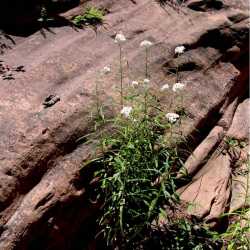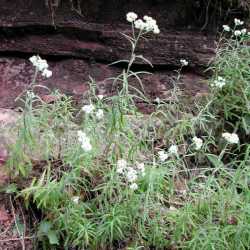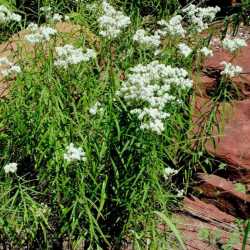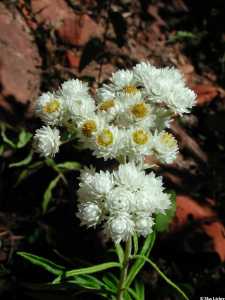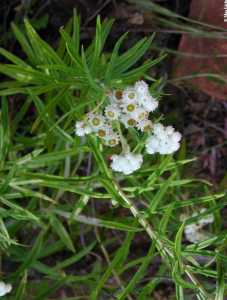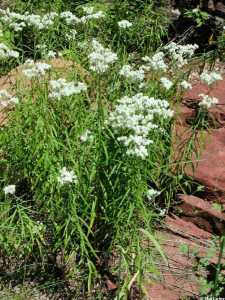Perennials; rhizomes relatively slender. Stems white, densely and closely tomentose, not glandular. Leaf blades 1-3-nerved, 3-10(-15) cm, bases subclasping, decurrent, margins revolute, abaxial faces tomentose or glabrescent (proximal leaves), not glandular or very sparsely and inconspicuously glandular, adaxial faces green, glabrate. Involucres 5-7 × 6-8(-10) mm. Phyllaries ovate to nearly linear (innermost), subequal to unequal, apices white, opaque. Cypselae 0.5-1 mm, bases constricted into stipiform carpopodia. 2n = 28.
Flowering Jul-Oct (sporadically longer). Dry woods, often with aspen or mixed conifer-hardwood, borders and trails, dunes, fields, roadsides, other open, often disturbed sites; 0-3200 m; St. Pierre and Miquelon; Alta., B.C. , Man., N.B., Nfld. and Labr., N.W.T., N.S., Ont., P.E.I. Que., Sask., Yukon; Alaska, Ariz., Ark., Calif., Colo., Conn., Del., Idaho, Ill., Ind., Iowa, Ky., Maine, Md., Mass., Mich., Minn., Mont., Nebr., Nev., N.H., N.J., N.Mex., N.Y., N.C., Ohio, Oreg., Pa., R.I., S.Dak., Tenn., Tex., Utah, Vt., Va., Wash., W.Va., Wis., Wyo.; Mexico (Baja California); Asia; introduced in Europe.
Anaphalis margaretacea was widely planted as an ornamental and escaped. It apparently naturalized from its native range in both Asia and North America; it is cultivated and naturalized in Europe.
Anaphalis margaritacea has the aspect of Pseudognaphalium; it differs in being subdioecious (polygamo-dioecious; the heads either staminate or primarily pistillate) and in its distinctive cypselar vestiture. It is further recognized by its combination of rhizomatous habit, subclasping-decurrent, bicolor, revolute leaves, and distally white phyllaries. Segregate species and varieties have been described among the North American plants (in addition to the two cited above), based on variation in habit, vestiture, and leaf morphology and density, but the variants appear to be more like a complex series of ecotypes rather than broader evolutionary entities.
This is a northern species which has been reported several times from Indiana. In nearly every instance the author has failed to report Gnaphalium obtusifolium which doubtless occurs in every county of the state. Without doubt all or most of our authors have confused the two plants When a study is made of the two, it is easy to understand how they could be confused. This species is perennial, stoloniferous, has papery, white, finely striate, spreading involucral bracts while in Gnaphalium the bracts are yellowish white or brownish, not striate, and subappressed, and this species lacks the balsamic odor which is characteristic of Gnaphalium obtusifolium. I have Anaphalis margaritacea from Elkhart County and Potzger has collected it in Morgan County. These are the only specimens I have seen.
Indiana Coefficient of Conservatism: C = 3
Wetland Indicator Status: FACU/UPL
General: Perennial, 15-90 cm tall; stems erect; herbage densely white tomentose, becoming rust colored with age; rhizomes slender.
Leaves: Basal and cauline, alternate, the basal and lower cauline leaves soon deciduous, lanceolate to narrowly oblong or linear, 3-15 cm long, 0.5-2 cm wide, 1-3 veined, green and nearly glabrous above, white tomentose or nearly glabrous below, margins entire, revolute, bases somewhat clasping, apex acuminate; blades sessile.
Flowers: Heads numerous, arranged in racemes, staminate heads above, pistillate heads below; staminate heads nodding, saucer-shaped, 2-4 mm wide, shallowly and obscurely lobed, usually with 1-3 black veins, disk flowers only, 3-25, greenish yellow to yellow; pistillate heads clustered in the axils of upper leaves, disk flowers solitary; flowers July-October.
Fruits: Achene, oblong, 0.5-1 mm long, the surfaces somewhat scabrous; pappus of 10-20 barbed bristles.
Ecology: Forest openings, meadows, streambanks, roadsides, disturbed habitats; 1100-2800 m (3600-9200 ft); Apache, Coconino, Graham, Pima, Pinal, and Yavapai counties; widespread throughout North America.
Notes: A. margaritacea can appear similar to Pseudognaphalium or Gnaphalium;however, Anaphalis is rhizomatous, its leaves are densely hairy only below, and it has broad, bright white phyllaries, whereas the other two genera are taprooted, have leaves that are densely hairy on both surfaces, and have narrower, greenish or yellow-tinged phyllaries. Pearly everlasting colonizes readily following fire and establishes well from seed. It is a host plant for the painted lady butterfly and makes an attractive ornamental. The Paiute use the stems to cover baskets filled with berries. It has many medicinal uses, including as an anti-inflammatory and astringent in tea form. It is also used for burns, sores, colds, lung disorders, rheumatism, dysentery, diarrhea, and stomach flu. Leaves, stems, and flowers impart fragrance when placed among linens and clothing.
Editor: Springer et al. 2008
Rhizomatous, 3-9 dm, leafy, loosely white-woolly, or the pubescence rusty in age; lvs numerous, all cauline, lanceolate or linear, to 12 נ2 cm, sessile, commonly less pubescent above than beneath, or glabrous above, the margins often revolute; heads 1 cm wide or less, numerous and crowded in a short, broad infl; invol 5-7 mm, its bracts pearly-white; achenes papillate; 2n=26. Various habitats, chiefly dry and open; n. N. Amer. and e. Asia, s. to Va., W.Va., Neb., and Calif. July, Aug. Highly variable.
Gleason, Henry A. & Cronquist, Arthur J. 1991. Manual of vascular plants of northeastern United States and adjacent Canada. lxxv + 910 pp.
©The New York Botanical Garden. All rights reserved. Used by permission.


